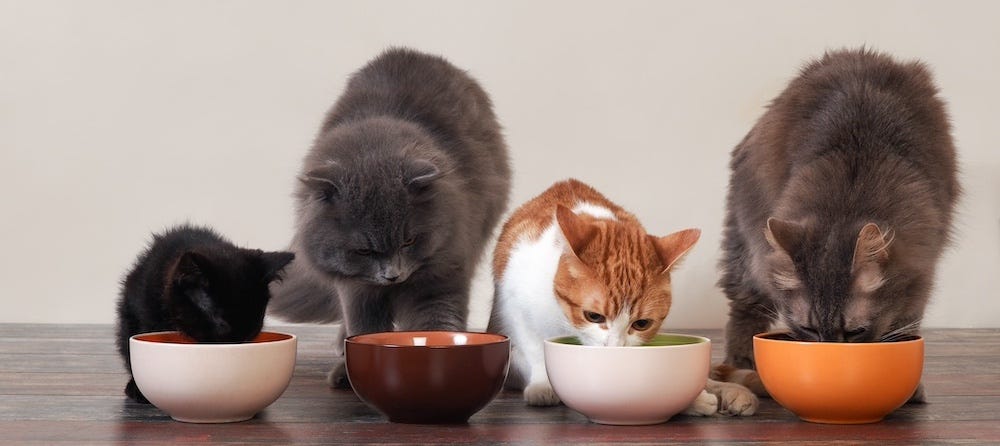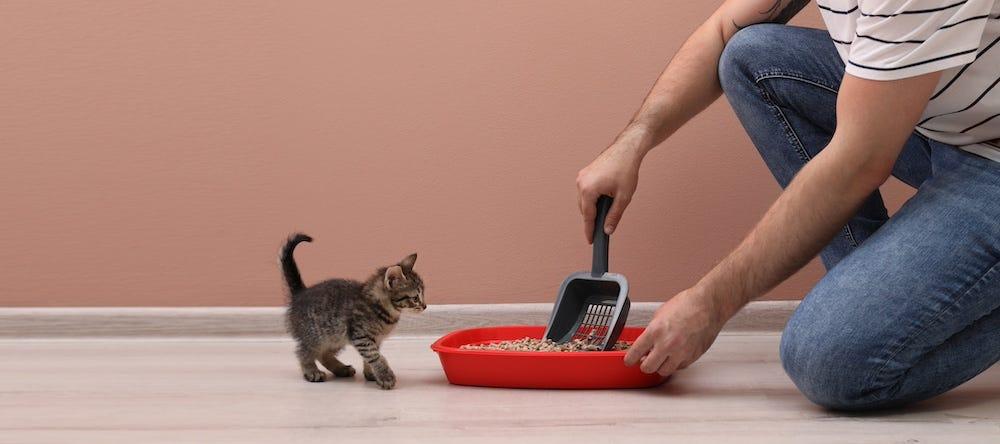Was your cat just diagnosed with liver disease or jaundice (a yellow hue of the skin)? Here’s what you need to know about liver disease in cats.
Cats seem to be really susceptible to liver disease, and they can only go a few days without eating before they develop secondary fatty changes to the liver. The medical term for this is hepatic lipidosis, which is often called “fatty liver.” If your cat was just diagnosed with hepatic lipidosis, you’ll want to read up on it here.
The mistake I see even veterinarians making? Just because a cat is sick, jaundiced, and has increased liver enzymes doesn’t always mean that your cat has “fatty liver.” There are numerous causes for liver disease in cats, and a prompt, thorough workup with treatment is necessary for the best outcome.
Causes of liver disease in cats
Some of the top causes that I see for liver disease in cats include:
- Hepatic lipidosis
- Cholangitis/cholangiohepatitis (inflammation of the bile ducts and/or the surrounding liver tissue)
- Pancreatitis
- Diseases of the gallbladder and bile duct (like cancer, gallbladder stones, secondary obstruction, etc.)
- Cancer (like lymphoma, adenocarcinoma, and more)
Less common causes of liver disease in cats include:
- Feline infectious peritonitis (FIP)
- Poisons causing liver damage (e.g., sago palm, Amanita mushrooms, acetaminophen/paracetamol)
- Other types of infections (e.g. Toxoplasma, liver flukes)
- Abnormal blood flow going through the liver (e.g., portosystemic shunts)
- Rare drug reactions to commonly used veterinary medications (e.g., methimazole, oral benzodiazepine, etc.)
- Liver cysts
- Amyloidosis, accumulation of abnormal protein in the body
Now, if you’re a gambling man (or woman) and your cat is diagnosed with jaundice, chances are your cat has either hepatic lipidosis or cholangitis/cholangiohepatitis. These two diseases comprise approximately two-thirds of the causes for jaundice in cats. But, what about the other third of the time? It’s one of these other, rarer causes, which have a much worse prognosis.
You may not want—or be able to—invest thousands of dollars into the workup, diagnosis, treatment, and anesthesia for a feeding tube if the cause for liver disease turns out to be untreatable or have a really bad prognosis! Plus, it might be a lot to put your cat through if the prognosis is really grave.
Clinical signs of liver disease in cats
So, what do you need to be on the lookout for? Signs of liver disease in cats can be really subtle, and often look similar to a host of other medical problems. For that reason, it’s really important to get to your veterinarian immediately if you notice any of these signs, especially if it’s been going on for more than a few days. Signs of liver disease in cats include:
- Eating less to nothing at all
- Vomiting
- Drooling
- Lethargy
- A subtle yellow hue to the tips of the ears, eyes and mouth (this is very difficult for pet parents to pick up on, so don’t feel bad!)
- Hiding in unusual places (closet, basement, under the bed, etc.)
- Smaller urinary clumps or fecal bulk in the litter box (due to decreased appetite or not eating)
- Dehydration
- Weight loss
- Muscle wasting, especially over the spine or pelvic area
- A distended abdomen
- Fluid accumulation in the belly
In severe cases, more severe signs may be seen secondary to liver failure, including:
- Behavior changes
- Acting abnormal (depressed, non-responsive)
- Walking drunk
- Collapse
- Bruising, especially after phlebotomy, due to abnormal clotting
- Abnormal behavior progressing to abnormal neurologic signs (such as head-pressing into a corner of the wall, staring off into corners, tremoring, or even seizuring)
- Seizures
- Coma (e.g., secondary to hepatic encephalopathy, where the poisons in the body that the liver should normally break down accumulate)
- Black tarry stool (e.g., melena)
- Death
How to diagnose liver disease in cats
In order to make a diagnosis of liver disease, your veterinarian will need to get a thorough history, do a complete physical examination, and start with several initial blood tests. The most important workup will be an ultrasound and aspirate of the liver.
Initial tests that your veterinarian can do include:
- A complete blood count (CBC) to evaluate the red and white blood cell count, along with the platelet count
- Specific blood tests to evaluate liver function (including an ammonia and bile acids test)
- A biochemistry panel (“chemistry”) to evaluate the liver enzymes (including the ALT, AST, ALPK, GGT, total bilirubin levels), protein level, electrolytes, blood sugar, and kidney function
- A clotting test (called a PT/PTT test) to evaluate the body’s ability to clot (with liver failure, the body can’t convert Vitamin K well, which is important for clotting)
- X-rays (to look at the size of the heart and organs, and rule out cancer metastasis to the lungs)
Depending on what these initial tests show, a referral to a veterinary specialist (e.g., internist, criticalist, etc.) may be warranted for additional testing. This includes:
- Abdominal ultrasound (to look at the “inside” or architecture of all the organs)
- A liver aspirate or biopsy (done by ultrasound-guidance) to remove a few cells or small amount of tissue for analysis. By “aspirating” a few liver cells out and evaluating them on a slide, this will help determine what is going on in the liver, and differentiate other causes for jaundice
- Placement of a temporary feeding tube
What are the risks of aspirating the liver in cats with liver disease?
What happens when we’re doing a liver aspirate? We’re using a tiny vaccine-sized needle (typically a 22-gauge needle) in order to pull a few cells out from the liver. These are put on a slide and sent off to a laboratory to be evaluated by a board-certified veterinary pathologist for interpretation. Be prepared that the results of the cell analysis (what we call “cytology”) take several days to get back. That said, it shouldn’t affect treatment of the liver disease, as it’ll still be the same pending results!
There are a few rare risks of liver aspirates that need to be discussed with your veterinarian. Bleeding can occasionally occur from the aspirate site. As jaundice cats often have abnormal clotting, a clotting test should ideally be done first.
Two other rare risks associated with aspirating the liver include getting a non-diagnostic sample from blood contamination. As you can imagine, the liver is a very “bloody” organ, and sometimes secondary bleeding can interfere with the aspirate results. Another smaller risk is that there could be cancer in one area and we are aspirating two centimeters over and may “miss” the diagnosis. If the latter of these two complications occur and we don’t get a definitive answer, the next set is a biopsy performed under sedation or brief anesthesia. This is where we use a biopsy gun to remove a small piece of tissue, versus just cells. Biopsies are taking more tissues, so there are more risks of complications compared to aspirates.
All that said, don’t be too nervous: The risks of aspirates are generally low, and I do this procedure almost every day in the veterinary ER. In my opinion, aspirates are really important to make sure something deadlier isn’t going on in your cat’s liver.
Treatment of liver disease in cats
Once we’ve done the appropriate tests to evaluate your cat’s liver, we’ll want to get your cat’s liver disease treated immediately. If liver disease goes untreated in cats, it can progress to liver failure and be life-threatening. That’s why you and your veterinary team want to find out what the exact cause of the liver disease is, and start treatment as soon as possible.
Typically, depending on what specific type of liver disease your cat has, treatment includes:
- 24-hour care for at least 2-3 days
- Intravenous fluids to help hydrate the patient
- Anti-vomiting medication
- Antacids
- Appetite stimulants (e.g., cyproheptadine or mirtazapine)
- Placement of a temporary feeding tube to provide adequate calories (this may be necessary for several weeks)
- Antibiotics
- Corticosteroids, if cholangitis/cholangiohepatitis is present
- Blood pressure monitoring
- Frequent monitoring of the liver values while hospitalized
- Vitamin K1 (to help fix clotting problems, if abnormal)
- Symptomatic supportive care
- IV protein (e.g., Hetastarch) if the protein level is low
- Plasma transfusions, if clotting abnormalities are seen
- Diet changes (potentially to a liver-friendly diet)
- Surgery (rare, only for certain conditions such as shunts, gallbladder stones, biopsies, etc.)
What’s the prognosis for a cat with liver disease?
Depending on what the underlying cause of the liver problem is in cats, the prognosis can vary from good to grave. The prognosis is good for hepatic lipidosis, cholangitis/cholangiohepatitis, toxins, and even pancreatitis. But the prognosis is very poor for cancer or other rarer diseases.
Keep in mind that with any sickness in your pets, the sooner you and your veterinarian diagnose it, the less expensive it is to treat. More importantly, know that liver disease in cats (even with aggressive treatment) can sometimes result in liver failure and death, and result in a costly visit at an ER vet. When in doubt, get to your veterinarian if your cat shows any worrisome signs.
Cover photo by Kari Shea on Unsplash









